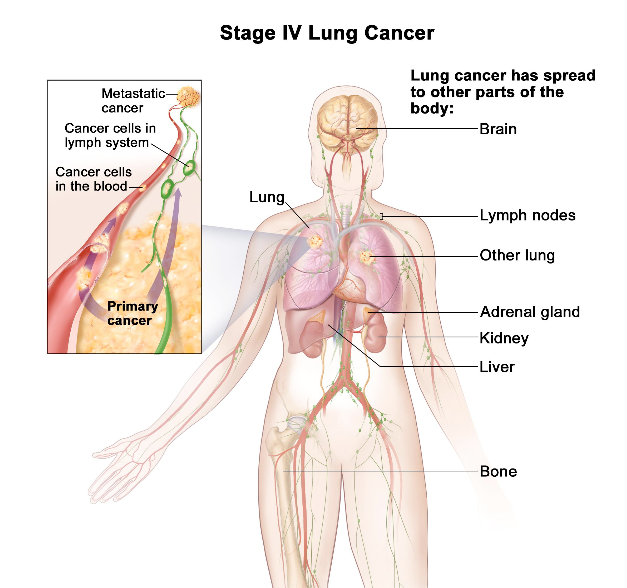When cancer cells on a tumor in the lung break away and migrate throughout the body via the bloodstream or lymph system—vessels carrying fluids through the body—it is known as lung cancer metastasis. This condition can occur either when lung cancer is first diagnosed or after receiving treatment for it. Lung cancer will commonly metastasize before it is even recognized because of the lack of recognizable symptoms. The cancer cells migrate to other organs, spreading the cancer.

Where Does Lung Cancer Spread To?
If lung cancer metastasizes, the usual places it spreads to are the lymph nodes, the brain, bones, the liver, and/or the adrenal glands. It will rarely spread to the kidneys, intestines, pancreas, or stomach. Knowing the common areas to which it spreads helps the doctor to pinpoint the cancer cells.
Symptoms
Symptoms of metastatic cancer do not always manifest themselves. But when they do, they are related to the place the cancer has spread to. Symptoms tend to be general and may not have anything to do with metastasized cancer, but connected to other problems.
Sites where lung cancer metastasizes may exhibit a variety of symptoms. If you know what to look for, you may be able to recognize the symptoms, and thus address the problem sooner.
- When cancer cells migrate to the adrenal glands, there are ordinarily no symptoms. Unexplained tiredness and weakness may signal lowered adrenal hormones, which is a result of cancer cells present.
- Pain and bones that break easily may indicate that the lung cancer has metastasized to the bones. As many as forty percent of lung cancer patients develop bone metastases.
- If the cancer cells have traveled to the brain, symptoms are nausea, headaches, weakness, tiredness, and confusion. Non-small-cell lung cancer accounts for eighty-five percent of all lung cancer, and of that percentage, twenty to forty percent will develop brain cancer.
- When lung cancer metastasis occurs in the liver, expect to experience jaundice, appetite loss, post-meal nausea, or pain on the right side underneath the ribs.
- Lymph nodes can swell during several illnesses, but if a person has lung cancer, it is very possible that the cancer has metastasized to them. Lymph nodes are located in the neck, stomach, and armpits.
Paraneoplastic Syndrome
Muscle cramps and muscle weakness, elevated levels of calcium in the blood, and clubbing—a change in the fingertips—are all symptoms of paraneoplastic syndrome. Paraneoplastic syndrome is the response of the body to a tumor, instead of to the cancer. This can occur in some cases when lung cancer spreads to other parts of the body. It occurs in approximately twenty percent of cancer patients. Sometimes the paraneoplastic syndrome symptoms occur before the lung cancer is diagnosed, leading the doctor to discover the cancer.
How Is Metastatic Lung Cancer Diagnosed?
One or more diagnostic tests and a physical exam will be ordered by your doctor if lung cancer metastasis is suspected. The following tests will confirm a metastatic lung cancer diagnosis. A chest X-ray will show a detailed picture of the lung. A CT scan will show a cross section of the lung in clear pictures. The doctor can perform a lung needle biopsy to remove and analyze a small lung tissue sample. A bronchoscopy allows the doctor to directly look at all of the respiratory system structures, which includes the lungs.
How Is Metastatic Lung Cancer Treated?
Controlling or stopping the growth of the cancer is the goal of all treatments, along with symptom relief. There are a number of various treatments available nowadays. Your treatment will be tailored to you and your cancer. Factors used to determine treatment plans include your age, medical history and general health, the type of the primary tumor, the size and location of the tumor, and the number of tumors present.
- Chemotherapy is used to treat advanced cancer that has spread to other organs in the body. It is often used to treat lung cancer metastasis. This form of therapy uses aggressive chemical drugs to destroy the cancerous cells. Sometimes, metastatic tumors will be surgically removed, especially if the primary tumor has been removed or if the spread is limited to the lung.
- Radiation therapy kills cancer cells and shrinks tumors through the use of high-energy radiation. Laser therapy employs high-intensity light to kill cancer cells and tumors. Stents—tiny tubes—can be placed to keep airways open.
- Heat probes can destroy lung cancer cells, and chemotherapy drugs can be administered directly to the metastatic tumor in/on the lung. Other experimental treatments are also available to treat metastatic lung cancer.
What Is the Prognosis of Metastatic Lung Cancer?
When lung cancer has metastasized to other parts of the body, it is classified as either extensive stage small cell lung cancer or stage four non-small-cell lung cancer. The exception is when it has metastasized to the lymph nodes, which can happen in the earlier stages of the cancer.
The survival rate for stage four non-small-cell lung cancer over a five-year period is a dismal two percent. The median survival rate is a mere eight months. This means the period of time when half of the people are still alive and half are dead. The extensive stage small cell lung cancer survival rate is also only two percent. With treatment, one might last six to twelve months; without, about two to four months.
However, some people have survived and lived well for a number of years, even after a metastasis diagnosis. Immunotherapy drugs and other newer treatments are offering hope to some that they may enjoy a lengthy survival. Every case is different, so these treatments don’t work for everybody. But some with advanced lung cancer are experiencing a long-term survival.
